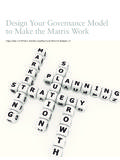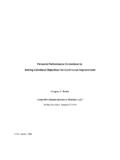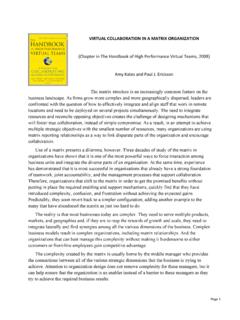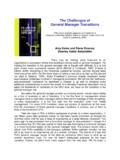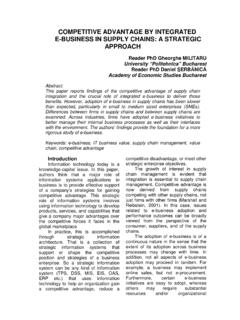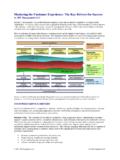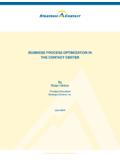Transcription of Designing Strategic Organizations - Amy Kates
1 Designing Strategic Organizations : The New Work of Executives and HRBy Gregory Kesler and Amy Kates , Kates Kesler organization Consulting** Parts of this article are excerpted from the book Leading organization Design: How to Make organization Design Decisions to Drive the Results You Want by Gregory Kesler and Amy Kates (Jossey-Bass, 2010), with 33/ISSUE 3 2010 15is able to keep many balls in the air at once through a web of structure , business process and human relationships. It is a very difficult design for competitors to copy. HR s Role In Guiding organization DesignGuiding a leader through a significant orga-nization design project with the goal of building new capabilities may be some of the most important and complex work that a human resource professional can undertake.
2 It requires a deep, trusting relationship with the client, knowledge of the business , and an ability to bring broad HR domain expertise talent, organization , change, learning, compensation and project management to the effort. The internal HR or OD professional also needs to bring an organization design toolkit and well-developed consulting skills if he or she wants to influence, and not just support, the design process. We often hear some varia-tion on the following from internal HR and OD staff: I m brought in too late on decisions or my client doesn t believe that using a pro-cess and involving anyone beyond the current executive team is even worthwhile.
3 How can facilitation support. If your HR staff wants to be positioned closer to strategy develop-ment, rather than wait to be handed implementation work, they need to be ready to provide business leaders with all the ele-ments to enable them to make better, faster and easier-to-implement organization design of an Effective Design DecisionHuman resources can support leaders in the organization design process in the following five ways:1. Define the Right Problem2. Use Effective Design Frameworks3. Involve the Right People in the Process4. Tie Talent and organization Together5.
4 Implement the Change1. Define the Right ProblemThe first step to effective organization design is to build a business case for change. The business case is made up of the key elements of the strategy, an analysis of the current state of organization , and a clearly defined set of design s general managers understand the importance of organizational capabilities to compete, but many are less clear how to create them. They grapple with the question of how to align the compo-nents of the organization to execute strategy and remove barriers so that members of the organization can make the right decisions and do their best New, Complex Work of LeadersAs business strategies become more com-plex, leaders have to do more than be able to inspire individuals and guide the work of teams.
5 Leaders also have to understand organization . To make good organization decisions, leaders need to have a robust diagnosis of the issues and opportunities, an involvement strategy to ensure they con-sider a wide range of views and engage key stakeholders, conceptual frameworks to guide trade-offs, and a disciplined project management approach to turn decisions into action. business strategies and organizational forms are more complex than ever for a number of reasons: Global expansion and the reality of competing with ever more sophisticated local players Changing business models and the need to manage a portfolio of varied business models Innovation in process as well as product Efficiency pressures to increase volume, reach and capability without adding overhead expenseOrganizations will be as complex as the strat-egies they are designed to execute.
6 The ability to manage a multi-dimensional organization that is capable of executing a multi-faceted strategy actually provides competitive advan-tage over firms whose management can only do one thing well. For example, today s IBM We long have been fascinated by the overlap between leadership and organization development. One of the most difficult challenges for new general managers, who have been promoted after leading functional teams in marketing, sales or operations, is to make their leadership impact scalable across a multi-dimensional organization .
7 A working knowledge of organization design has become an essential personal competency for successful senior add value earlier in the decision-making pro-cess and give my business leaders confidence in my ability to manage this work? organization design decisions support strat-egy execution. We often see the strategy function asked to lead and guide the project, with HR used only as an adjunct team mem-ber or engaged narrowly for staffing or Clarify the Strategic Priorities. Sound orga-nization design decisions depend upon a clear strategy, as organization design is a first step in turning Strategic thought into action.
8 Any-one involved in the design process must understand the strategy and its implications, and agree that achievement of the strategy will lead to superior results for the company. If the strategy is vague, full of conflicting 16 PEOPLE & STRATEGY objectives, or so broad that it does not set out clear choices, it will not lead to a workable organization . If the strategy has not been explained and understood fully, stakeholders coming into the design process will bring dif-ferent assumptions that will lead to conflict rather than creativity. Finally, if those who must execute the strategy do not believe it will lead to a better future, then there will be little commitment to undertaking the hard work of organizational change.
9 The work of HR often starts with facilitating a strategy clari-fication the Case for Change. Once the high-lights of the strategy are called out clearly, you can assess the current state and under-stand the problem you are trying to solve. The task is to assess the current structure s ability to deliver the key elements of the strategy. This often means identifying gaps, but the organization problem is not always a gap. We work with many successful companies where the leadership of the organization defines a future change in the environment created by new technology, geographic expansion or competitor moves, and initiates a proactive shift in strategy while the current business remains strong.
10 The problem in this case is that the current structure is now misaligned to execute its new build a compelling case for change, you must complete a current state assessment that includes financial data, customer feedback and interviews and focus groups with leaders and employees in the organization . HR adds value by objectively gathering the data and providing an integrated and actionable anal-ysis of the issues and the Design Criteria. To gain the most benefit from a change in organization , go beyond fixing today s problems to think about capabilities needed 12-36 months into the future that will differentiate the business from its competitors.

